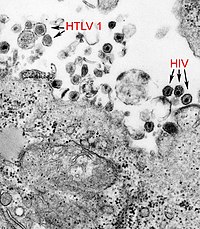
Photo from wikipedia
Previous studies have demonstrated the development of pulmonary impairment in individuals infected with human T-lymphotropic virus type 1 (HTLV-1). Complications, such as alveolitis and bronchiectasis, were found in individuals who… Click to show full abstract
Previous studies have demonstrated the development of pulmonary impairment in individuals infected with human T-lymphotropic virus type 1 (HTLV-1). Complications, such as alveolitis and bronchiectasis, were found in individuals who developed tropical spastic paraparesis/HTLV-1-associated myelopathy (TSP-HAM) due to chronic inflammation. These patients exhibited increased levels of lymphocytes (CD4+ and CD25+), cytokines (IL-2, IL-12, and IFN-γ), inflammatory chemokines (MIP-1α and IP-10), and cell adhesion molecules (ICAM-1) in the bronchoalveolar lavage fluid, with the result of chronic inflammation and lung injury. The main lesions observed at Chest high-resolution computed tomography were centrilobular nodules, parenchymal bands, lung cysts, bronchiectasis, ground-glass opacity, mosaic attenuation, and pleural thickening. It can lead to progressive changes in pulmonary function with the development of restrictive and obstructive diseases. Recent studies suggest a causal relationship between HTLV-1 and pulmonary diseases, with intensification of lesions and progressive decrease in pulmonary function. This summary updates a previous publication and addresses the general lack of knowledge regarding the relationship between TSP-HAM and pulmonary disease, providing direction for future work and the management of these individuals.
Journal Title: Frontiers in Immunology
Year Published: 2022
Link to full text (if available)
Share on Social Media: Sign Up to like & get
recommendations!